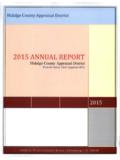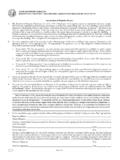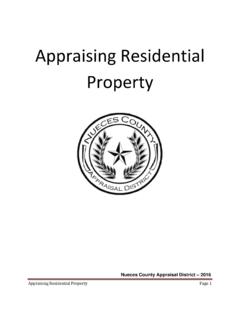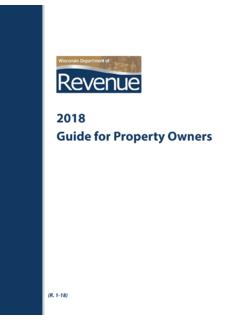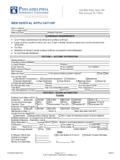Transcription of Basic Property Appraisal - Hidalgo County …
1 Basic Property Appraisal Hidalgo County Appraisal District 4405 S. Professional Dr Edinburg, Texas 78539 1 HOW IS YOUR Property APPRAISED? Property TAX ADMINISTRATION In Texas, Property owners pay Property taxes based on the market value of their Property . This is sometimes referred to as ad valorem taxation, meaning "according to value". In order to employ a system of ad valorem taxation, two Basic functions must take place. First, a taxable value for the Property is determined each year. Secondly, local taxing jurisdictions such as cities, schools, counties, and other entities authorized to levy a Property tax need to apply a tax rate to that value in order to calculate the amount of taxes owed for that year on that Property .
2 In 1979, the Texas legislature created Appraisal districts in each County . One of the primary roles of Appraisal districts is to annually determine the market value of all of the properties, also referred to as tax parcels, within its County s boundaries. Once established these values are certified to the assessor/collector for each taxing jurisdiction in the form of an Appraisal roll. At this point the assessor/collector submits the rolls to the governing body for each taxing jurisdiction as the tax roll. The taxing jurisdictions then use these Appraisal rolls to calculate the tax bills to be sent to Property owners. Calendar of Events The Property tax system in Texas works from a calendar of events.
3 An example of the Texas Property Tax Calendar can be found at: Appraisal DISTRICTS Appraisal districts are administered by a chief appraiser who, assisted by his staff, oversees the day-to-day operations of the district. The function of the Appraisal district is to appraise properties and administer exemptions. More information regarding Appraisal districts can be found at: Value Appraisal districts follow the provisions of the Texas Property Tax Code. The Tax Code requires that, unless otherwise provided, that all taxable Property be appraised at its market value as of January 1st of that tax year. The Tax Code defines market value as: The price at which a Property would transfer for cash or its equivalent under prevailing market conditions if: (A) exposed for sale in the open market with a reasonable time for the seller to find a purchaser; (B) both the seller and the purchaser know of all the uses and purposes to which the Property is adapted and for which it is capable of being used and of the enforceable restrictions on its use; and (C) both the seller and purchaser seek to maximize their gains and neither is in a position to take advantage of the exigencies of the other.
4 Exemptions While they do not affect the market value of the Property , exemptions "exempt" or excuse a portion of the value of the Property from taxation. Homestead exemptions apply only to the Property owner 's principle residence. Homestead exemptions include a general homestead, 2 over 65 homestead, disabled person homestead, and 100% disabled veteran s exemption. More information regarding exemptions can be found at: Notices A Notice of Appraised Value informs the Property owner if the Appraisal district intends to increase the value of a Property . Chief appraisers send two kinds of notices of appraised value. A detailed notice contains the description of the Property ; taxing units allowed to tax the Property ; preceding year's appraised value; preceding year's taxable value; current year's appraised value; allowed exemptions; estimate of taxes based on previous year's tax rates; statutory language; explanation of how to protest; ARB hearing information; and an explanation that the Appraisal district only determines a Property 's value and does not decide on tax increases.
5 A detailed notice is sent if: the value of a Property is higher than it was in the previous year (The Appraisal district's board can decide that it will send detailed notices only if a Property 's value increases by more than $1,000.); the value of a Property is higher than the value the Property owner gave on a rendition (see next section); or the Property was not on the Appraisal district's records in the previous year. If these conditions do not apply, the chief appraiser sends a short notice that includes only the previous year's appraised value; the current year's appraised value; allowed exemptions; explanation of how to protest; and ARB hearing information. A short notice is sent when a Property is reappraised or changes ownership, or upon request of the Property owner or authorized agent.
6 Tax Code Section requires the chief appraiser to send the notice of appraised value by May 1 or April 1 for residence homesteads, or as soon thereafter as possible. If a Property owner disagrees with this value, the Property owner has until May 31 or 30 days from the date the notice was mailed (whichever is later) to file a protest with the Appraisal review board (ARB). The notice of appraised value includes a protest form and information about how and when to file a protest with the ARB if the Property owner disagrees with the Appraisal district's actions. 3 VALUATIONS Define the Problem The assignment of the Hidalgo CAD is to develop annual valuations for every Property located within Hidalgo County at market value with the effective date of January 1st.
7 The Property Tax Code instructs Appraisal districts to use generally accepted Appraisal methods when valuing Property , but it also requires them to consider each Property s individual characteristics when determining the Property s market value . Plan the Appraisal Project District appraisers must plan their work so they can collect and analyze the characteristics of their assigned properties and their market areas within the time frame set by the Property tax calendar. Generally, appraisers must allow enough time to physically inspect their properties, collect and analyze market data, and resolve any differences in the data prior to finalizing the proposed valuations necessary for the delivery of the Notice of Appraised Value.
8 Data Collection After the Appraisal roll has been certified in late July the next year s Appraisal project can begin. Appraisers review the prior year s work and begin to identify and develop data sources for the new Appraisal . These data sources include maps, permits, cost, sales, listings, income and expense information, publications, and field inspections, as well as other sources. Data Analysis Utilizing the data collected, the appraiser then considers the characteristics of each Property including, among other things, its use, site, zoning, improvements (buildings), and locational influences as well as comparable sales and listing. Reconciliation Appraisers then apply the data to three different methods of appraising Property .
9 They are commonly referred to as the three approaches to value. 1) The Cost Approach, using cost data, appraisers can develop cost manuals and depreciation schedules. 2) The Direct Sales Approach, using sales data, appraisers establish benchmarks properties for comparison purposes and develop appropriate adjustments used in the sales comparison analysis. 3) The Income Approach, the appraiser develop economic rents, expense allowances, and discount and recapture rates. The reconciliation process attempts to resolve differences in the results of the three approaches based on the reliability and credibility of the data. The reconciliation of the three approaches tends to be different depending on the type of Property being appraised.
10 A more detailed explanation of the valuation process of the four major Property types (land, residential, commercial and business personal Property ) and the Texas Property tax system can be found at: 4 In Texas, Property owners can protest, or appeal, any action taken by the Appraisal district that adversely affects the Property owner . These protests are adjudicated by the Appraisal Review Board (ARB), a citizen s board, whose members are appointed by a local administrative law judge. The ARB oversees the Appraisal records, and hears the protests and appeals. The most common reasons for filing protests concern market value and the uniformity of the district s appraisals. RESIDENTIAL Property VALUATION PROCESS What is Residential Property ?








